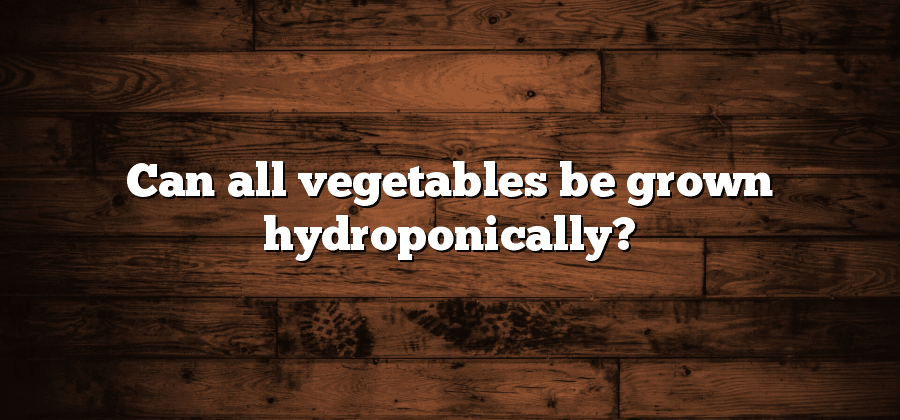Hydroponic Vegetable Cultivation: An in-depth Analysis
Hydroponic vegetable cultivation is gaining significant attention in the field of agriculture due to its numerous advantages. This method of farming involves growing vegetables without soil, using water-based nutrient solutions instead. By eliminating the need for traditional soil-based farming, hydroponics offers several benefits that contribute to sustainable agricultural practices.
One major advantage of hydroponic vegetable cultivation is the efficient use of resources. Growing vegetables hydroponically requires up to 90% less water compared to conventional farming methods. This is because the water in the system is recirculated, minimizing wastage. Additionally, hydroponics allows for precise control over nutrient levels, resulting in higher yields and faster growth rates. As a result, farmers can produce a larger quantity of vegetables in a shorter period, maximizing productivity. This efficiency makes hydroponics an attractive option, particularly in regions with limited water availability or small land areas.
Advantages of Hydroponic Farming
Hydroponic farming offers numerous advantages over traditional soil-based cultivation methods. One of the major benefits is the significant reduction in water usage. Since hydroponics utilizes a closed-loop system where water is constantly recirculated, the need for extensive irrigation is eliminated. This not only conserves water resources but also minimizes the risk of water wastage due to evaporation or runoff.
Another advantage of hydroponic farming is the precise control over nutrient levels. By directly supplying plants with a nutrient-rich solution, growers can tailor the exact amount and composition of nutrients based on specific plant requirements. This ensures optimal growth and development, leading to healthier and more productive crops. Additionally, this level of control allows for year-round cultivation, enabling farmers to have consistent harvests regardless of weather conditions or seasonal limitations.
Suitable Vegetables for Hydroponics
When it comes to hydroponic vegetable cultivation, certain vegetables are more suitable for this method than others. Leafy greens such as lettuce, spinach, and kale are popular choices due to their relatively fast growth rate and high yield potential. These vegetables thrive in a hydroponic system as they require less root space and can be grown in nutrient-rich solutions. Additionally, herbs like basil, mint, and cilantro are excellent options for hydroponics. Their compact growth habit and strong aroma make them perfect for indoor hydroponic gardens, providing fresh flavors for culinary enthusiasts.
Fruiting vegetables like tomatoes, cucumbers, and peppers can also be successfully cultivated using hydroponics. However, they come with their own set of challenges. These plants often require additional support structures to ensure the weight of the fruits does not cause damage. They also need specific nutrient ratios and environmental conditions to promote healthy growth and abundant fruiting. Nevertheless, with proper care and attention, hydroponic systems can provide a controlled environment that enables optimal growth for these vegetables.
Factors Influencing Hydroponic Vegetable Cultivation
One critical factor influencing hydroponic vegetable cultivation is the availability of sunlight or a suitable artificial lighting system. Plants require adequate light for photosynthesis, which is essential for their growth and development. In a hydroponic system, where plants are grown without soil, providing the right amount and quality of light becomes even more crucial. Different vegetable varieties have different light requirements, so it is essential to choose the appropriate lighting system and ensure that plants receive the optimal amount of light to thrive.
Another factor that exerts a significant influence on hydroponic vegetable cultivation is the nutrient solution used. In a hydroponic system, nutrients are supplied directly to the plants’ root systems in the form of a liquid solution. The nutrient solution must contain all the essential elements that plants need for their growth, such as nitrogen, phosphorus, potassium, calcium, magnesium, and trace elements. Maintaining the right balance and concentration of nutrients is essential for promoting healthy plant growth and maximizing yields. Understanding the specific nutrient requirements of different vegetable crops and regularly monitoring and adjusting the nutrient solution accordingly is crucial for successful hydroponic vegetable cultivation.
Nutrient Solutions for Hydroponics
Hydroponic vegetable cultivation requires careful attention to the nutrient solutions used. These solutions serve as a complete substitute for soil, providing the essential elements that plants need for growth and development. The main advantage of using nutrient solutions in hydroponics is that they can be precisely controlled to meet the specific needs of each plant species.
One of the key considerations when selecting nutrient solutions for hydroponics is to ensure that they contain the right balance of essential nutrients. These include macronutrients such as nitrogen, phosphorus, and potassium, as well as micronutrients like iron, manganese, and zinc. Achieving the correct nutrient balance is crucial to promote healthy plant growth, prevent nutrient deficiencies or toxicities, and maximize crop productivity. Additionally, the pH level of the solution should be carefully adjusted to suit the specific plant species being cultivated. By maintaining the optimum pH range, nutrients are more easily absorbed by the plants, leading to improved overall growth and yield.






